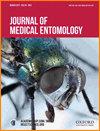1997-2020 年西班牙蜘蛛咬伤的医疗重要性比较:基于使用 ICD 编码的医院病例的回顾性研究
IF 2
3区 农林科学
Q1 ENTOMOLOGY
引用次数: 0
摘要
陆生有毒动物对人类健康的危害在全世界都很严重。医学文献主要关注蛇类、膜翅目昆虫、蜘蛛和蝎子。然而,只有少数几个国家对蜘蛛的相对重要性进行了研究。在此,我们首次对西班牙需要住院治疗的蜘蛛咬伤发病率进行了回顾性研究,并将其与蛇类、膜翅目昆虫和蝎子的咬伤或蛰伤进行了比较。利用世界卫生组织《国际疾病分类》中 1997-2020 年期间的 ICD9MC 和 ICD10 数据库,我们量化了与其他陆生有毒动物相比的蜘蛛致毒病例、致毒病例的人口统计学数据、蜘蛛咬伤的相对严重程度以及致毒病例的地理分布。总体而言,西班牙陆生有毒动物急性中毒的发病率约为每百万居民 1.23 例。依次为蛇、膜翅目动物、蜘蛛、蝎子和肌足类动物。致命病例极为罕见,主要由膜翅目昆虫引起。蜘蛛、蝎子和肌足类动物没有造成死亡病例。西班牙北部的蛇咬伤发生率较高,但没有发现蜘蛛咬伤或蝎子蜇伤的地理趋势。与世界其他国家相比,西班牙因被有毒陆生动物咬伤或蛰伤而导致严重中毒或危及生命的病例似乎很少,尤其是蜘蛛。总的来说,蜘蛛不会对人类健康构成威胁,也不应被视为发病的主要原因。本文章由计算机程序翻译,如有差异,请以英文原文为准。
Comparative medical importance of spider bites in Spain over 1997–2020: a retrospective study based on hospital cases coded using ICD
Envenomation by terrestrial toxic animals is considered a serious risk to human health worldwide. Snakes, hymenopterans, spiders, and scorpions have mainly attracted the attention of medical literature. However, the relative importance of spiders has been studied only in a few countries. Here, we present the first retrospective study on the incidence of spider bites requiring hospital care in Spain, compared to bites or stings from snakes, hymenopterans, and scorpions. Using ICD9MC and ICD10 databases from the World Health Organization’s International Classification of Diseases for the period 1997–2020, we quantified the cases of envenomation by spiders, compared to those by other terrestrial toxic animals, the demographic data of envenomation cases, the relative severity of spider bites, and the geographic distribution of envenomation cases. Overall, the incidence of acute intoxication by terrestrial toxic animals in Spain was ca. 1.23 cases per million inhabitants. In decreasing order of importance, cases were due to snakes, hymenopterans, spiders, scorpions, and myriapods. Fatal cases were extremely rare, caused mainly by hymenopterans. No fatalities were caused by spiders, scorpions, and myriapods. A greater incidence of snake bites occurred in northern Spain, but no geographical trends were found for spider bites or scorpion stings. Severe poisoning or life-threatening cases due to bites or stings from toxic terrestrial animals in Spain seems to be very low, especially for spiders, compared to other countries in the world. In general, spiders do not present a risk to human health and should not be considered a major driver of morbidity.
求助全文
通过发布文献求助,成功后即可免费获取论文全文。
去求助
来源期刊
CiteScore
4.60
自引率
14.30%
发文量
207
审稿时长
3-8 weeks
期刊介绍:
Journal of Medical Entomology is published bimonthly in January, March, May, July, September, and November. The journal publishes reports on all phases of medical entomology and medical acarology, including the systematics and biology of insects, acarines, and other arthropods of public health and veterinary significance. In addition to full-length research articles, the journal publishes Reviews, interpretive articles in a Forum section, Short Communications, and Letters to the Editor.

 求助内容:
求助内容: 应助结果提醒方式:
应助结果提醒方式:


